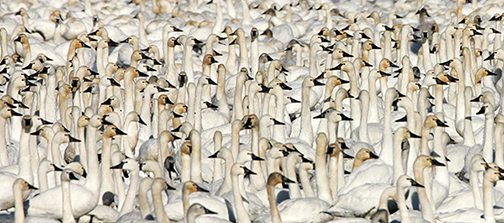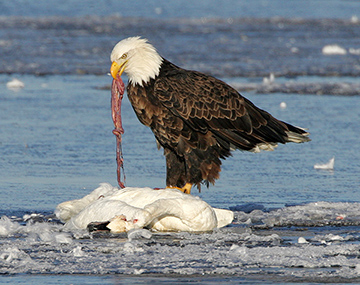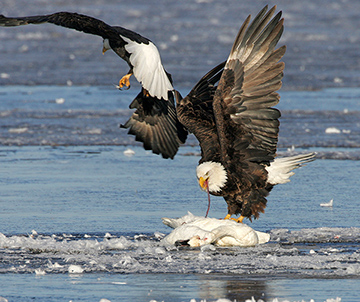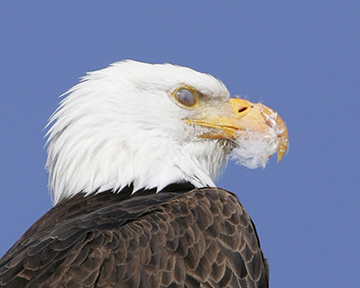The Eagles of Tulelake - published in Nature Photographer, 2008
Article and Images by Don Jedlovec

© Don Jedlovec, Field Contributor - A lamentation of Tundra Swans, Lower Klamath NWR,
Canon 1D MarkII with a 500 mm f/4 lens plus 1.4X teleconverter, shot at f/5.6, ISO 400
Author’s note: Unless indicated otherwise, the images presented here were shot at roughly the same settings: Canon 1D MarkII with a 500 mm f/4 lens plus 1.4X teleconverter, f/5.6, ISO 400. My equipment selections and settings were based on being able to get reasonable shutter speed (at least 1/1000 sec or so which is adequate to stop large birds in flight) in what were often overcast and snowy conditions. Also, I needed auto focus capability which favors a 1.4X teleconverter over a 2X. I feel performance at high ISO is good enough with modern digital backs, that, with the exception of certain critical large print situations, you can set ISO 400 and forget about it. Anyway, for the most part, in publications such as Nature Photographer the images are not reproduced in large enough scale where ISO noise becomes apparent. While we may fastidiously report the settings of aperture, focal length, and ISO, these numbers are really not meaningful unless the field of view in the original image is also provided. Given this information, one can determine how close the photographer actually was from the subject. Also, you can also better assess image quality and ISO performance. As an example:
The distance to subject can be obtained by the formula:
Distance = height (field of view) of what you see in the viewfinder x focallength ÷ height of your sensor.
For example, if you are shooting landscape orientation with a Canon 1D MarkII (sensor height 19 mm), with a 500 mm lens, and a 1000 mm tall eagle just fills the frame, you are 26,000 mm away, or about 75 feet.
Tulelake, California, population 1000, is in Northern California near the Oregon border in the Klamath Lake watershed. The area is arid in summer, and at elevation 4000 feet is snowy in winter. In February the Tulelake Bald Eagle population swells to 1000 or so, roughly equaling the population of the town itself. The area is in the Pacific Flyway for migrating waterfowl; this attracts many raptors in the winter months. The area is mainly agricultural. Tourism seems limited to hunting and birding; the latter is becoming more popular in recent times.

© Don Jedlovec, Field Contributor - Bald eagle consuming tundra swan, Lower Klamath NWR,
Canon 1D MarkII with a 500 mm f/4 lens plus 1.4X teleconverter, shot at f/5.6, ISO 400
Established in 1908 by Executive Order as a “preserve and breeding grounds for native birds dedicated to wildlife conservation for the purpose of waterfowl management but with full consideration to optimum agricultural use,” the Lower Klamath National Wildlife Refuge (our first one) and the nearby Tulelake Wildlife Refuge have been a hot bed of activity between farmers, hunters and birders. But interestingly, each one is interdependent on the other.
For birding, the Refuges have auto tour routes. You can see and shoot at lot just from a vehicle, and I did at lot of this. There are few trees in the area, so every sign and fence post offers a perch for raptor. The birds are accustomed to cars driving by; you can be assured full frame portrait (vertical) shots with no more than a 400 mm lens – if you are careful not the stop the car! Once you stop or get out, all bets are off as the birds are likely to flyoff.
There are several photo-blinds on the refuges that can be reserved. These blinds are strategically situated for morning sun and are opposite common perch points. The blinds are removed from the beaten path and passing traffic is prohibited from stopping within a quarter mile of the blinds. The blinds are not much larger than a closest and will accommodate two photographers – if you know each other well! You are pretty much assured a good clear view but your view is often looking up; I had better luck on the road.
Apart from the main auto tour routes, the refuge is criss-crossed with many roads and levees that cover the farms and wetlands of the refuge. My principal way of finding birds would be to drive along these roads in search of perched raptors, eagles feeding on carcasses, and assorted flocks of waterfowl and passerine.

© Don Jedlovec, Field Contributor - Bald eagles competing for tundra swan carcass, Lower Klamath NWR,
Canon 1D MarkII with a 500 mm f/4 lens plus 1.4X teleconverter, shot at f/5.6, ISO 400
Because of a lack of trees in the immediate area, the nearest communal bald eagle roost (where they spend the night) is at Bear Valley, several miles distant from the refuge proper. The roost is off limits to the public but you can go out at the crack of dawn to a nearby ridge and watch the ‘Bear Valley Flyout’ as the eagles begin their day in search of prey. You will see many eagles albeit from a large distance.
In the refuge, the principal prey for the bald eagles are tundra swans and snow geese. Both of these species winter in the area and at times the skies are white with them. Tundra swans are large birds, larger than the eagles. We had seen many eagles feasting on carcasses right in amongst the swans but never actually saw a kill. And we would go out as soon as the refuges opened but still did not see any action. While shooting a sunset one night I saw some coyotes trotting across the ice – perhaps the eagles were scavaging the coyotes’ kills? Now, I had imagined the eagles swooping down from the sky or even taking a swan in mid-air. The eagles are perfectly capable of doing but we decided that the pickings are far easier. In the middle of winter when most of the water is frozen over, large numbers of tundra swans congregate around the few patches of open water. We decided that that the eagles likely sit on the ice and wait for a sickly swan to appear and then they simply bite its head off. And the photography bears this out.

© Don Jedlovec, Field Contributor - This bald is sated on Tundra Swan, Tulelake NWR,
Canon 1D MarkII with a 500 mm f/4 lens plus 1.4X teleconverter, shot at f/5.6, ISO 400
Pocket gophers are another reason the eagles are here this time of year. Historically the farmers flood their fields in late winter. This flushes the rodents from their burrows and the eagles are waiting. It is worth the trip to the nearby fields in Doris to see the eagles congregate for this. You often see them atop irrigation equipment. Here again I imagined I would see eagles swooping down to subdue unsuspecting gophers – and they do – but no self-respecting pocket gopher would be anywhere near such convocations of perched balds. What happens is that the birds do swoop down - but in pursuit of gophers way, way, out of human plain sight. They take off pretty much horizontally and then, nearly out of sight, take their prey. This is a key point to keep in mind when you are trying to approach a raptor – they are aware of you long before you see them. I have learned to do things that do not threaten them in order to get close.

© Don Jedlovec, Field Contributor - Panorama of the Lower Klamath NWR, Levee in foreground, Tundra Swans in center. There are twenty Bald Eagles in this image.
My first trip to the Refuges years ago was shortly after Winged Migration premiered. I wanted to imitate the close-up flight images they got from the ultra-light aircraft in the film. So I went out to Doris where you can reliably see eagles perched. My technique involved shooting with a 300 mm f/2.8 lens, essentially ‘hunting’ the birds by getting as close as possible, walking back and forth, getting ever closer until the bird would fly away. At this point I would fire off a burst of ten or twenty images. This technique works particularly well when there is a white overcast sky because this seems to offer much higher contrast where the servo auto focus works better.
Birding is a lot more work here. It is nothing like South Florida in the wading bird breeding season, for example, but it will be well worth your effort. You will have a lot to talk about and knowledgeable people with whom to share your experiences.
If you are interested in visiting the refuges, keep in mind that the best times are:
Mid-February: Bald and Golden Eagles
November: Water fowl and raptors
Throughout winter: Passerine





